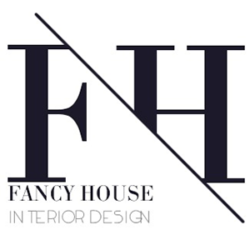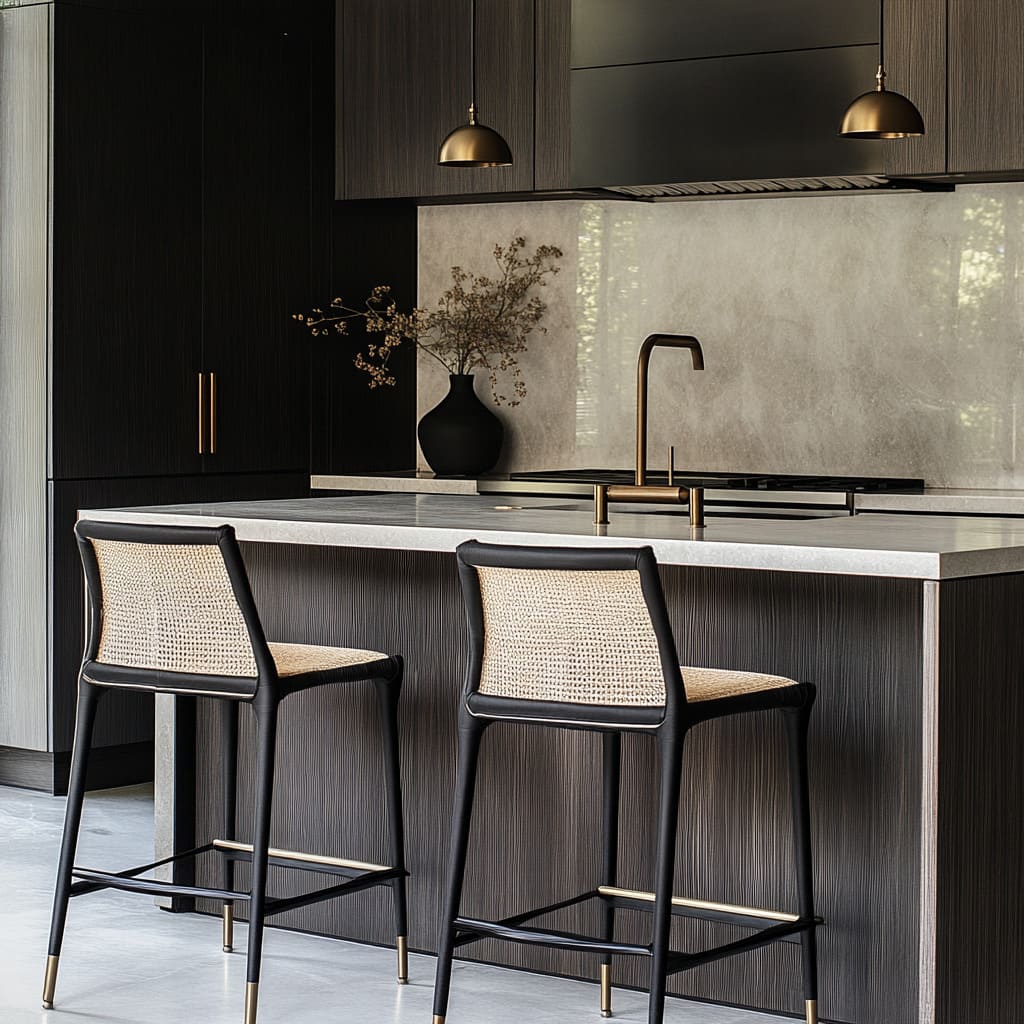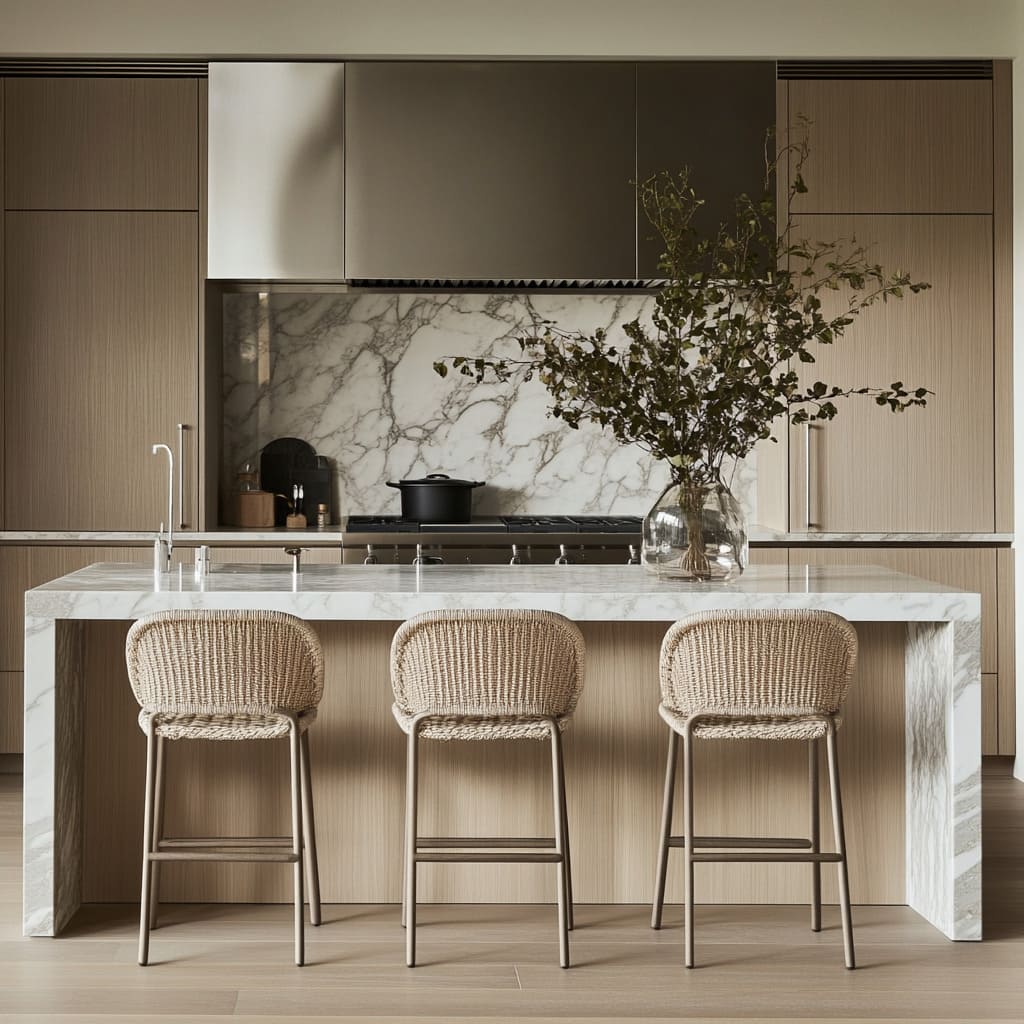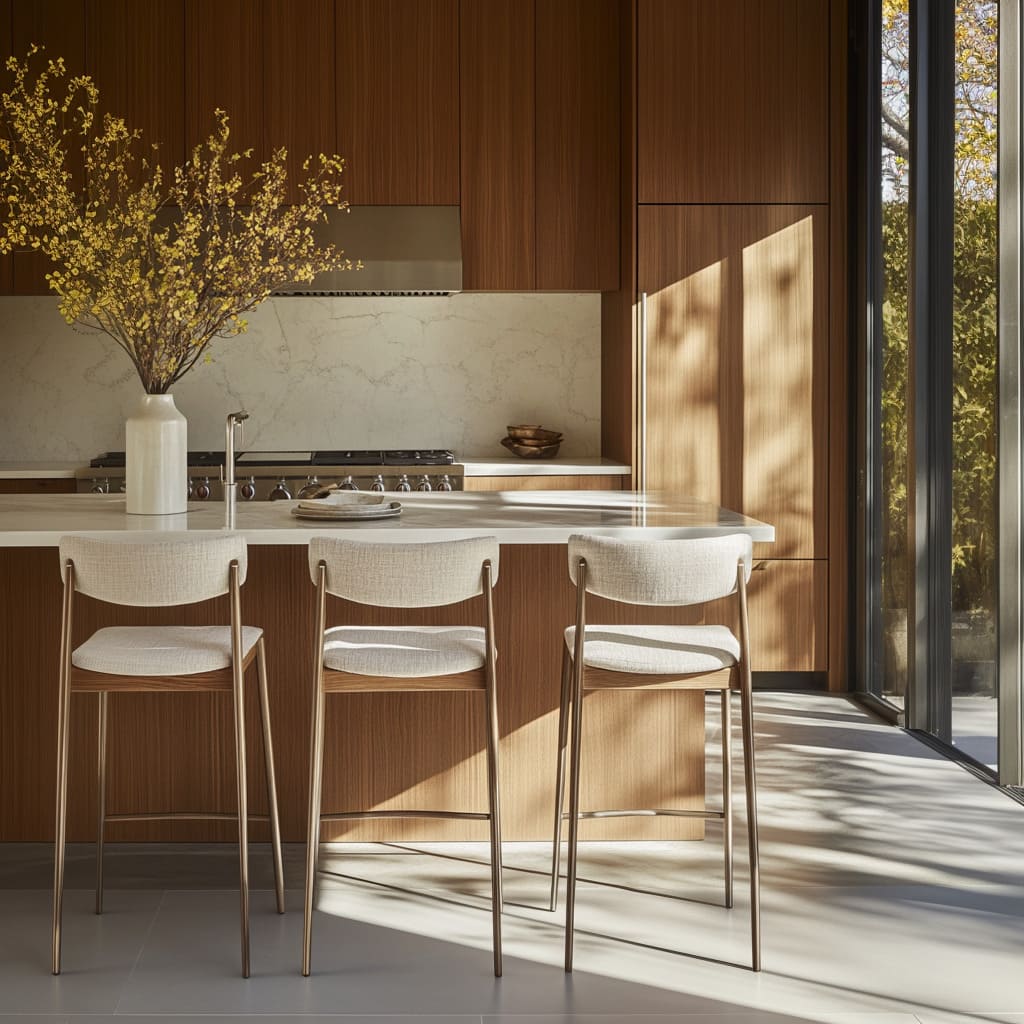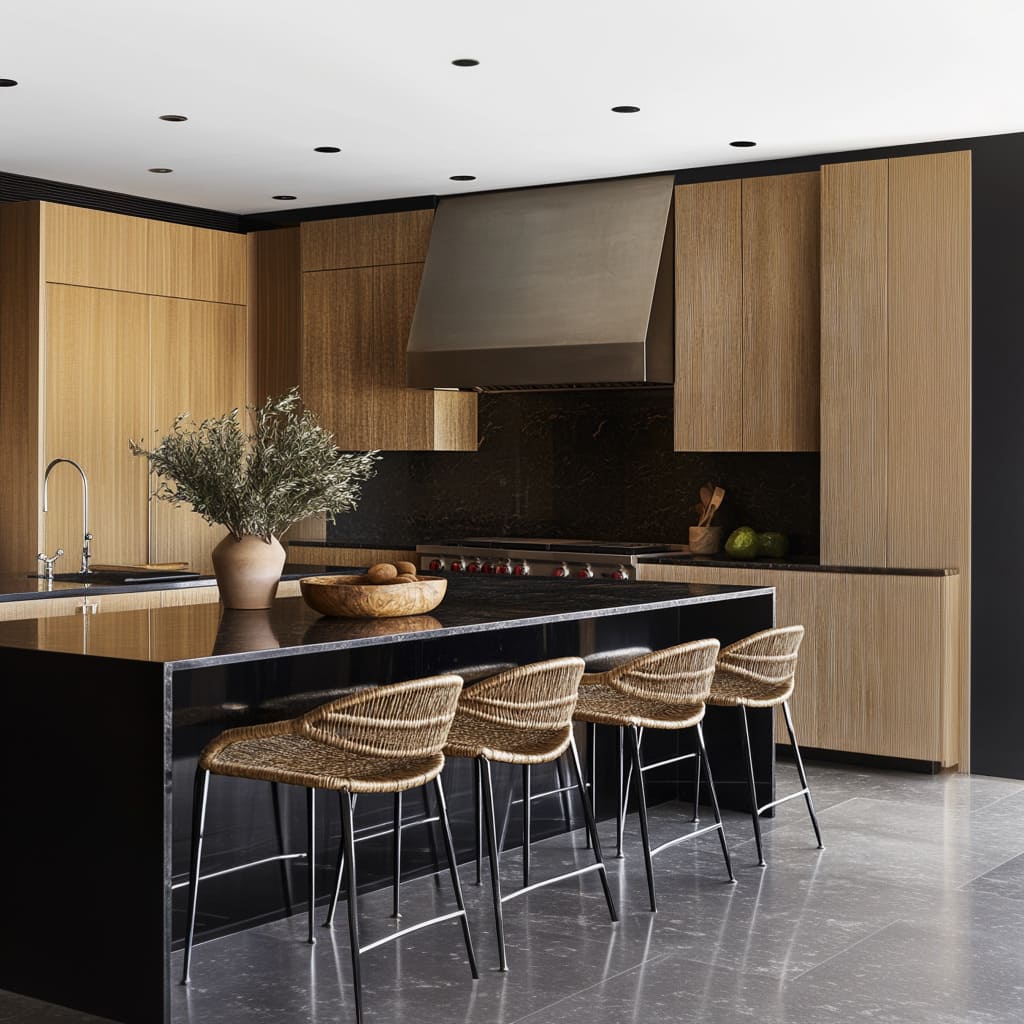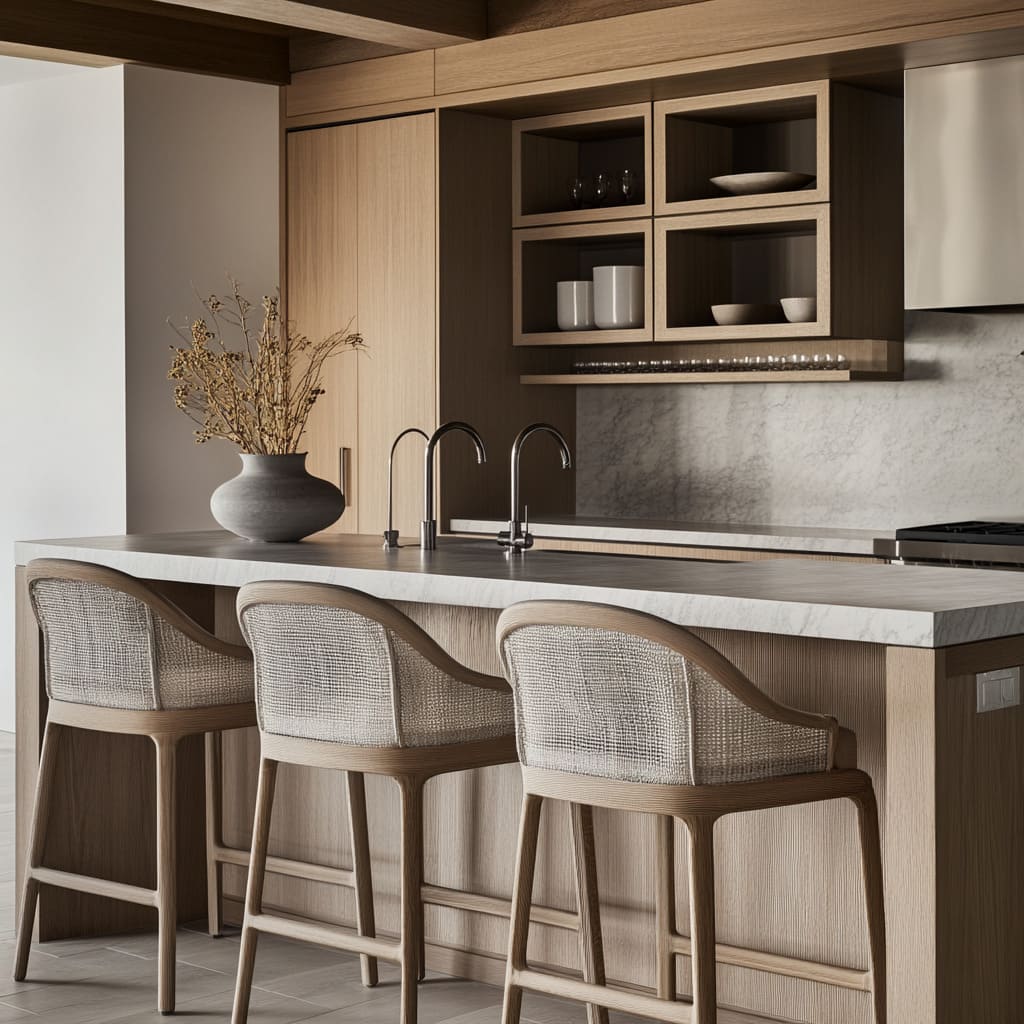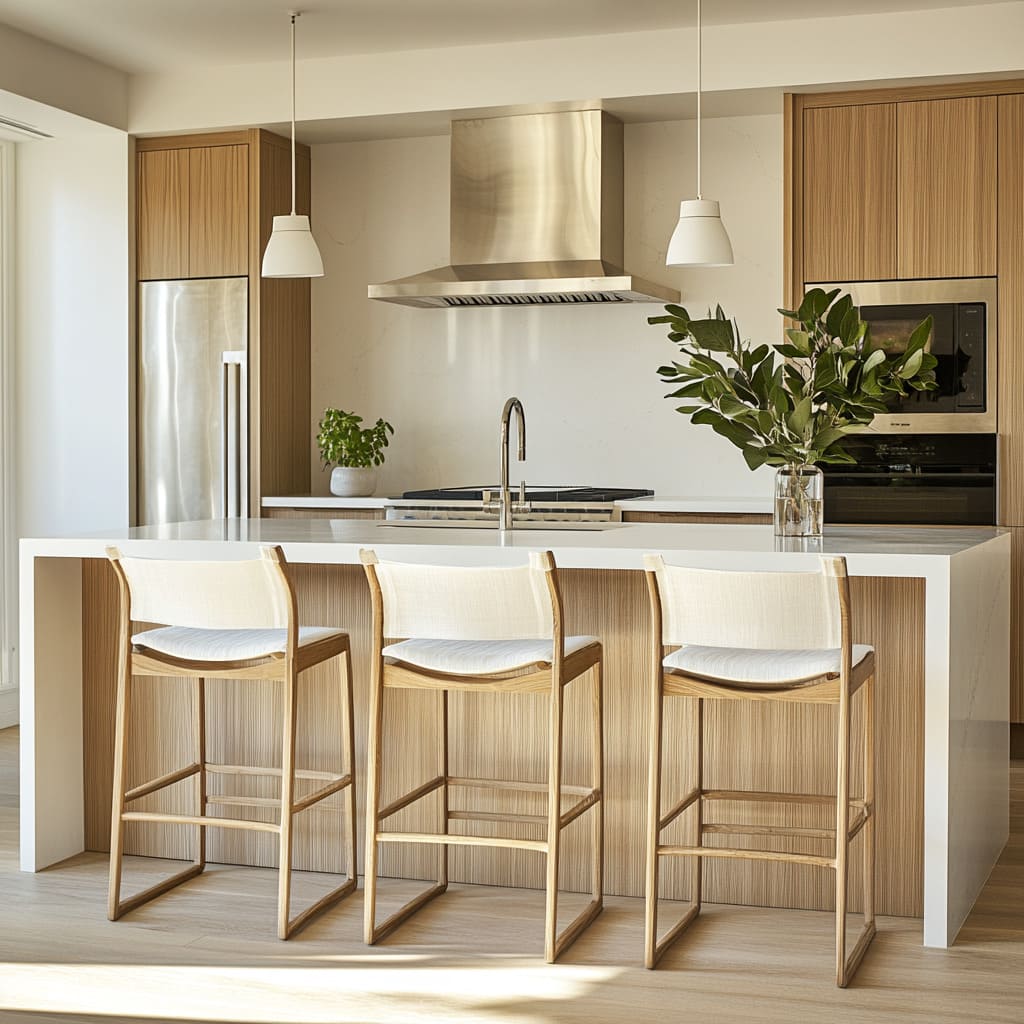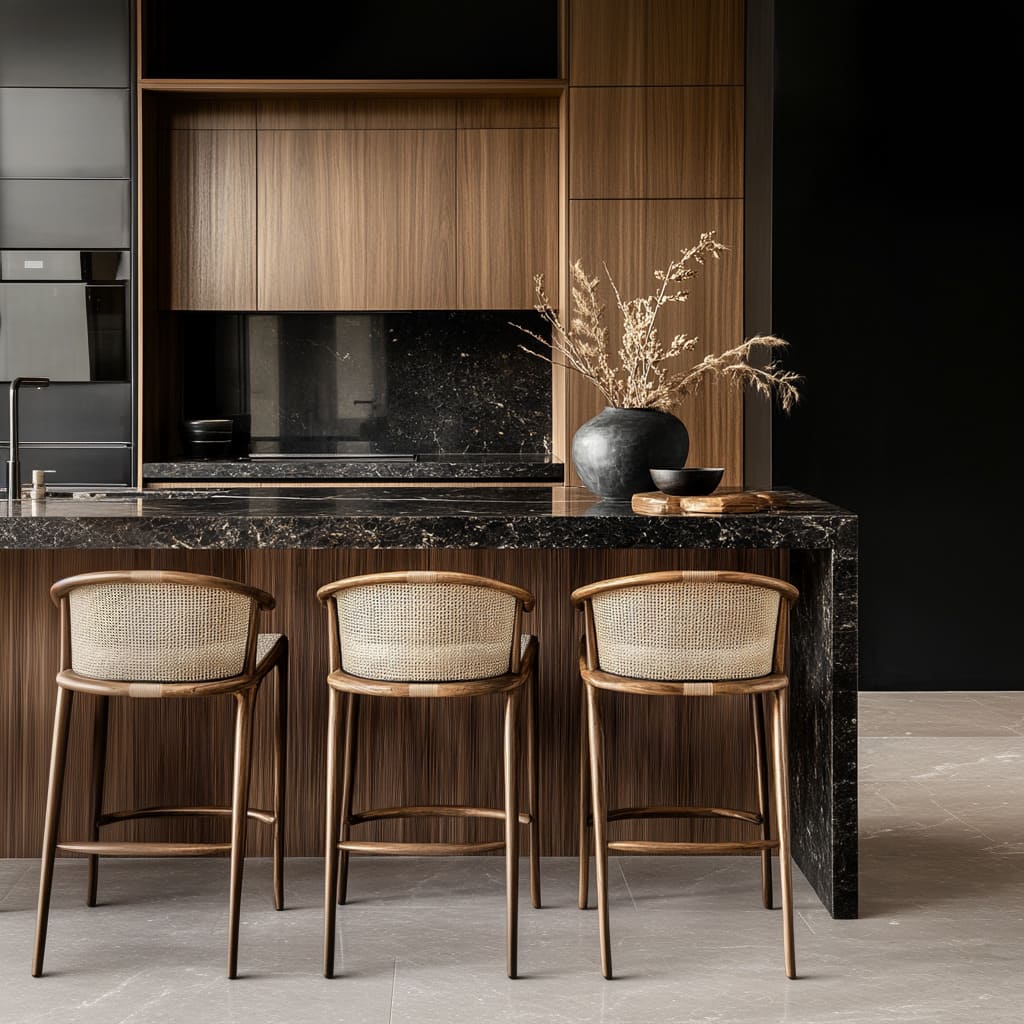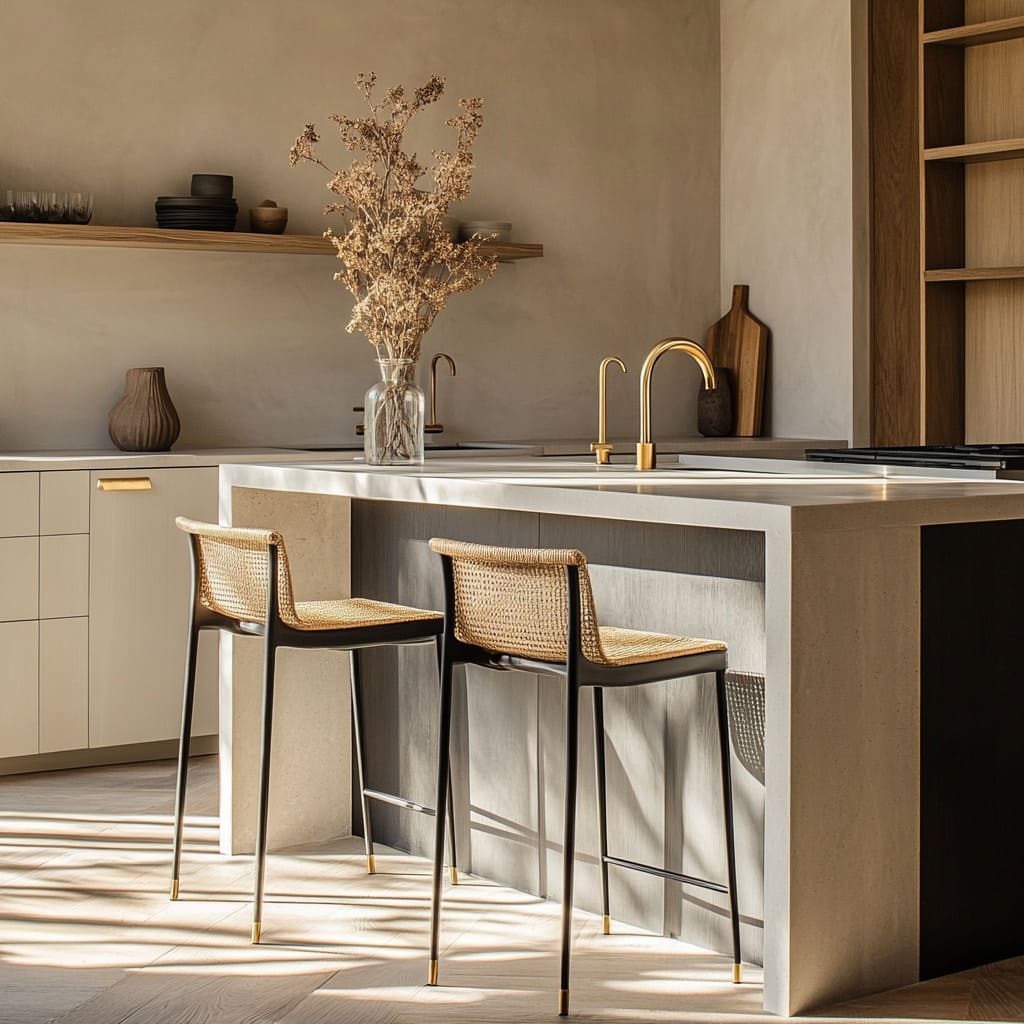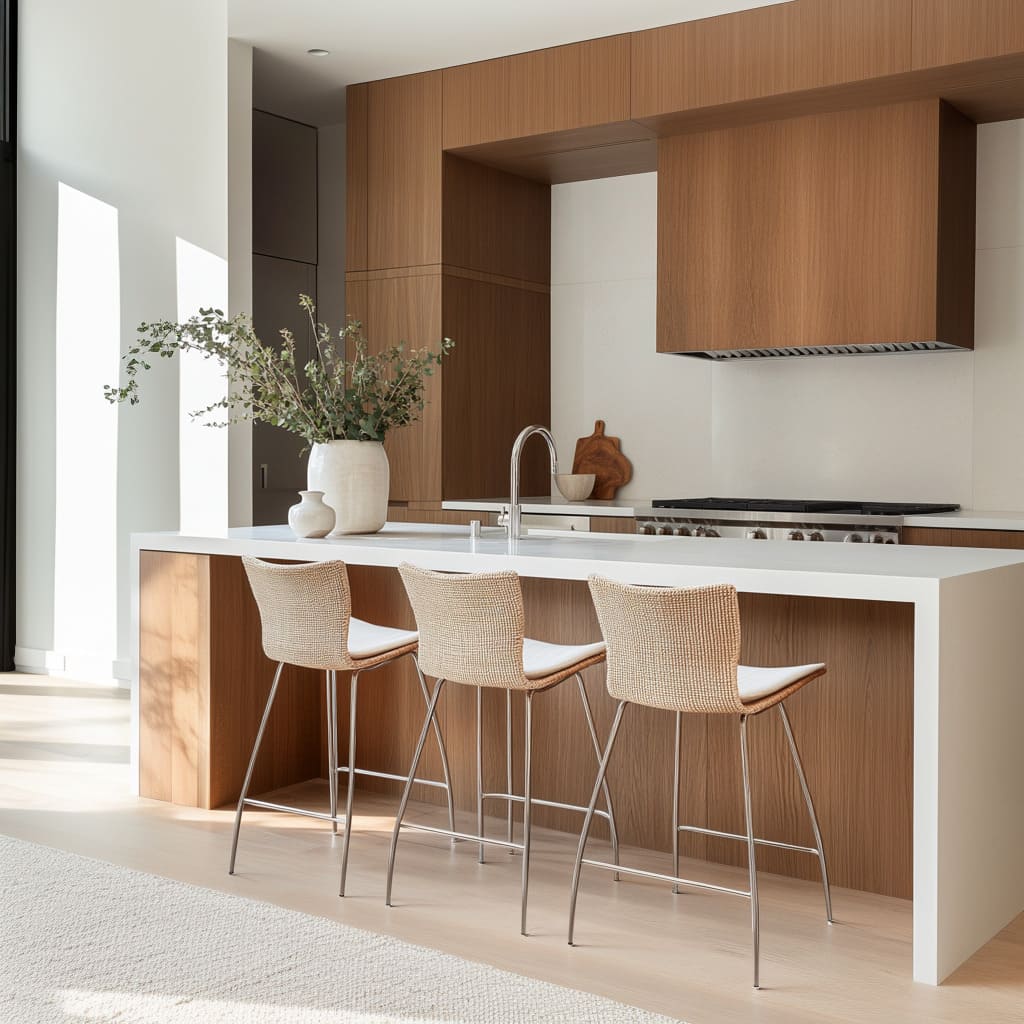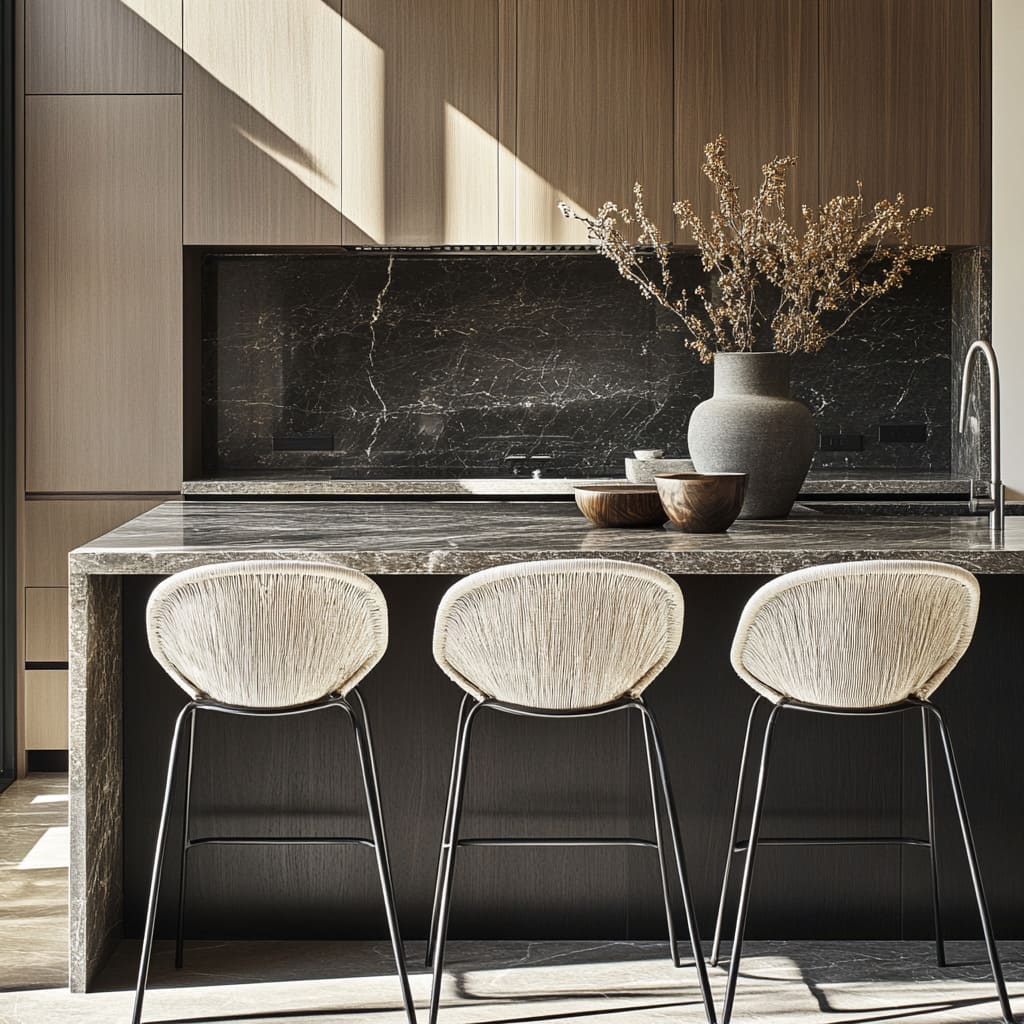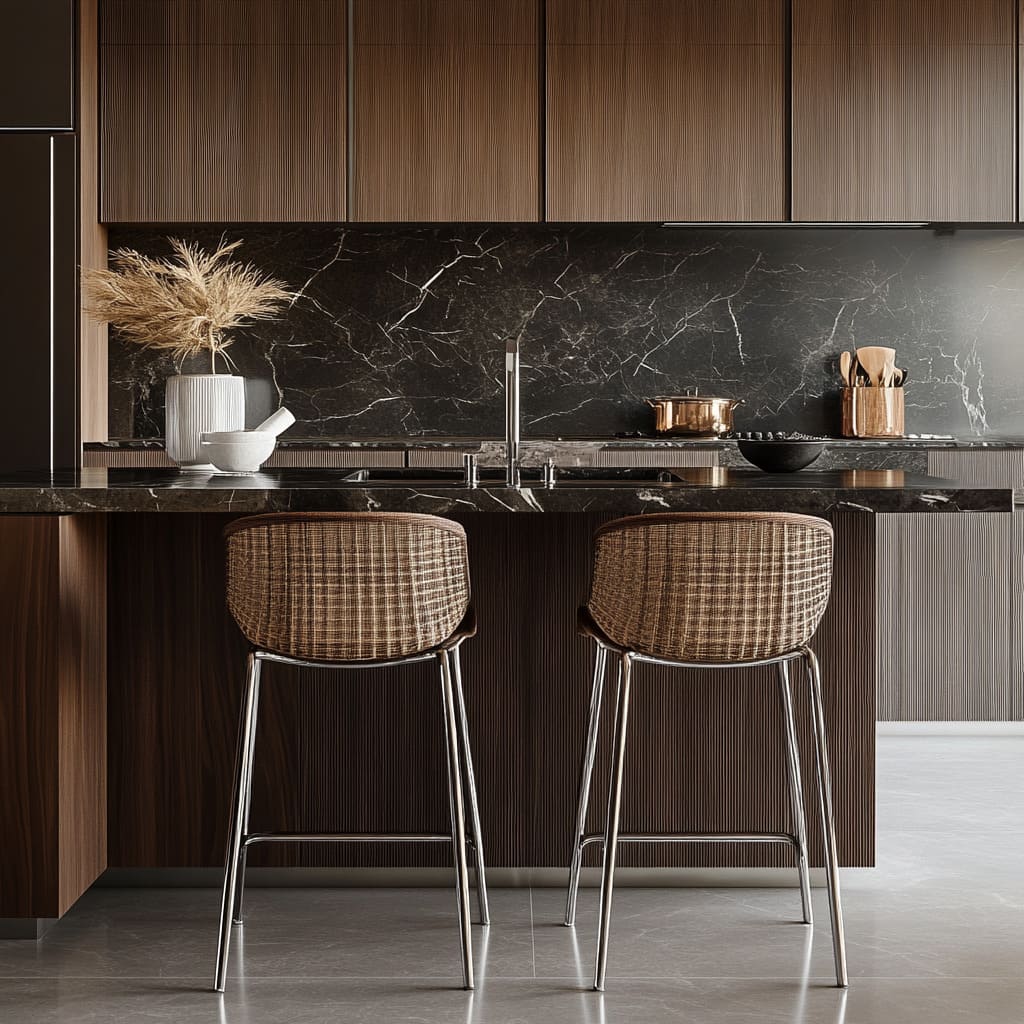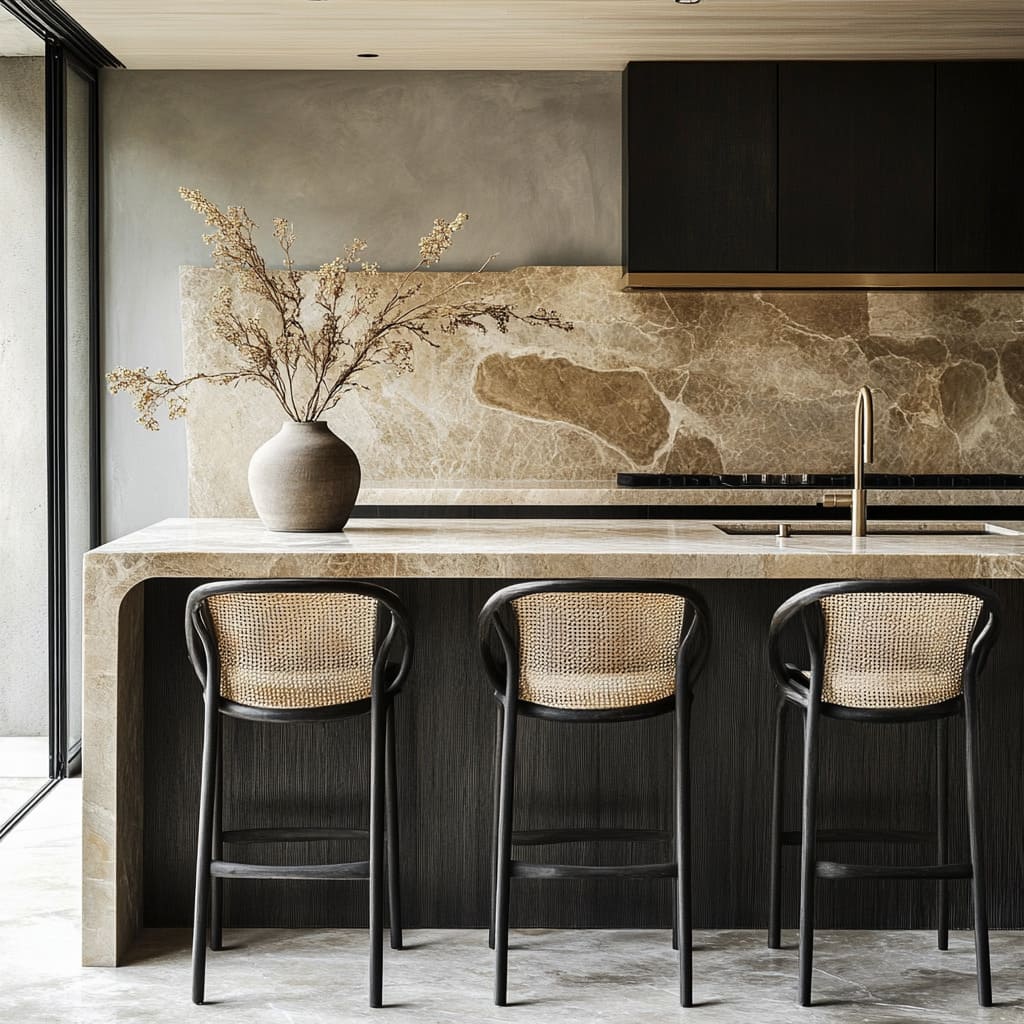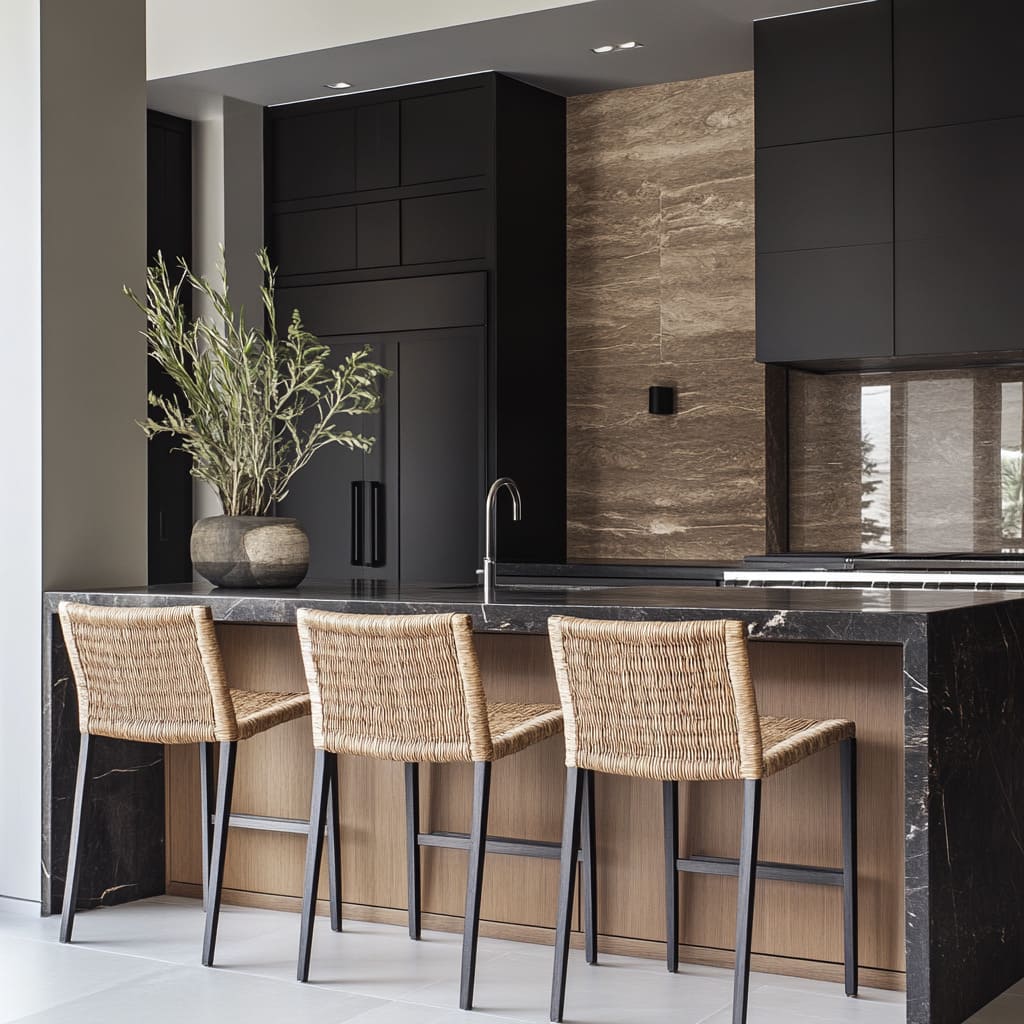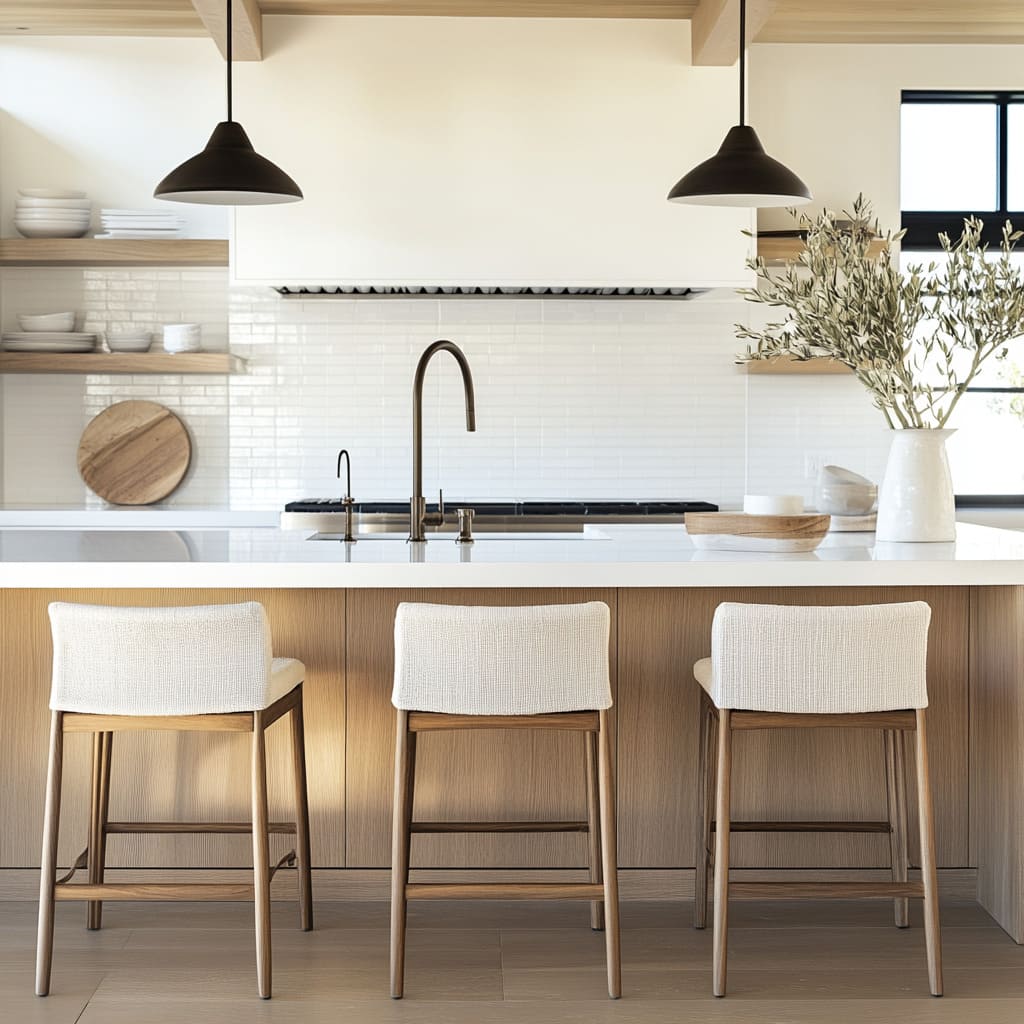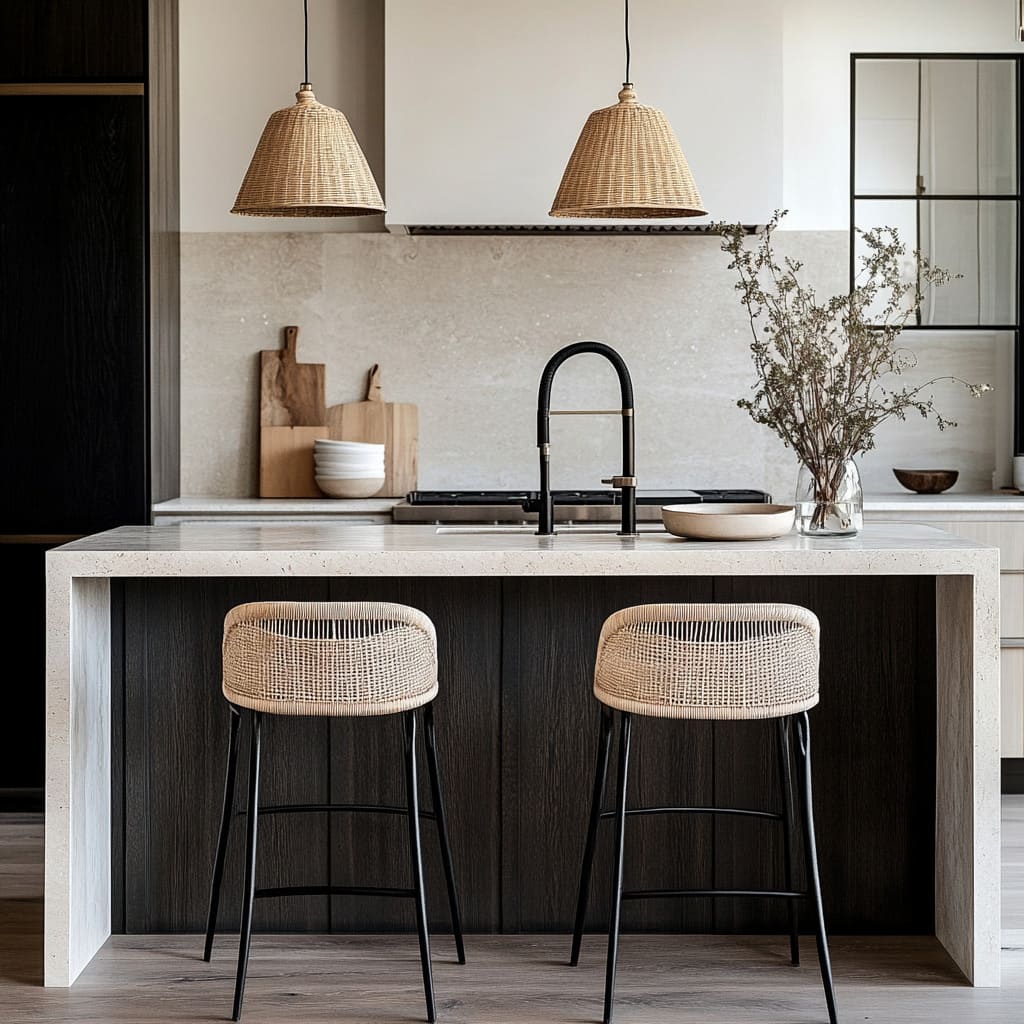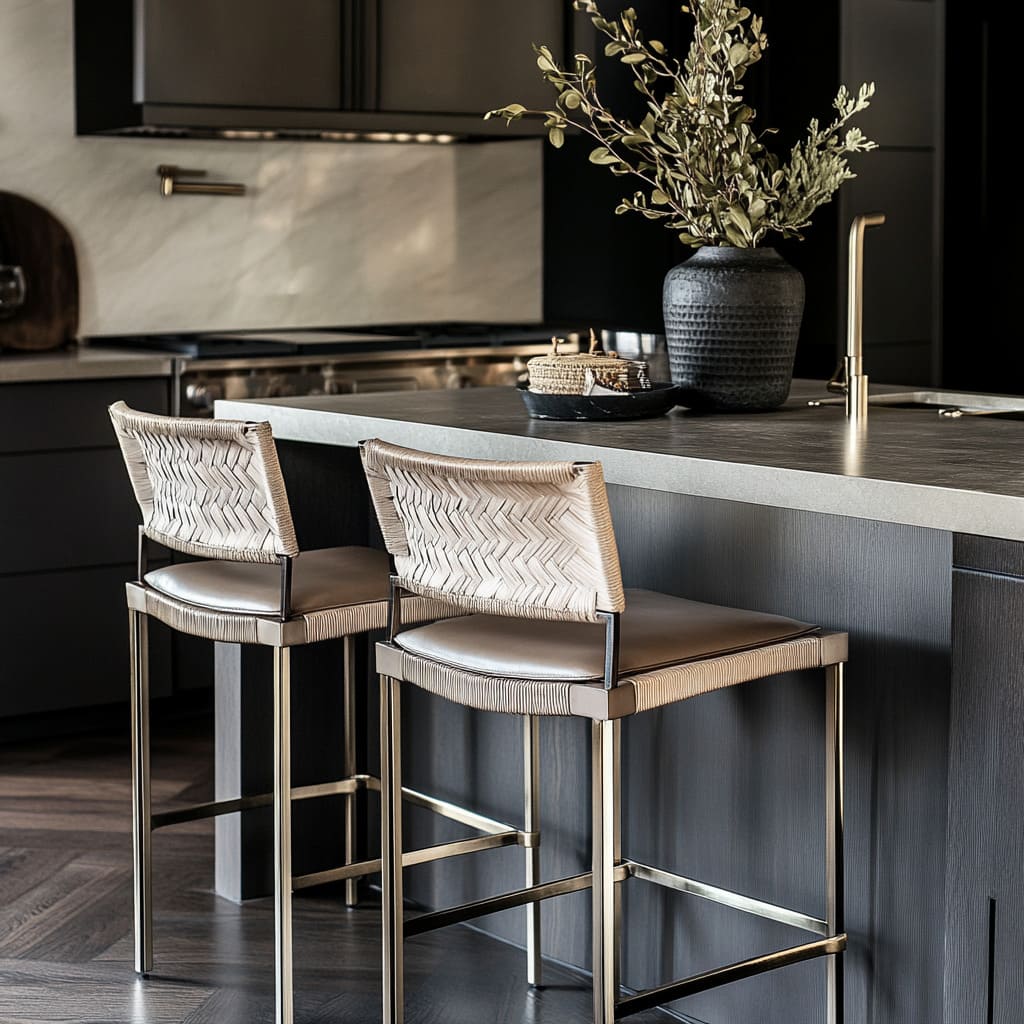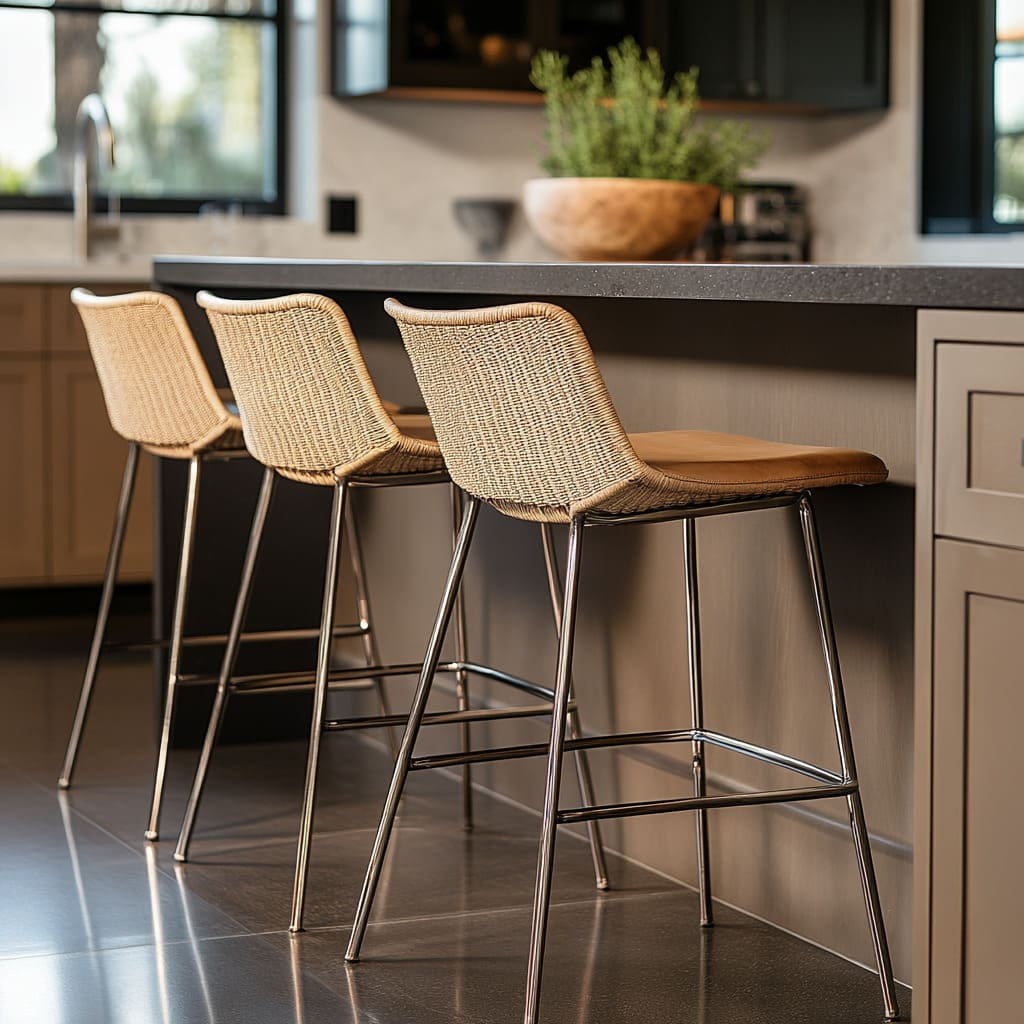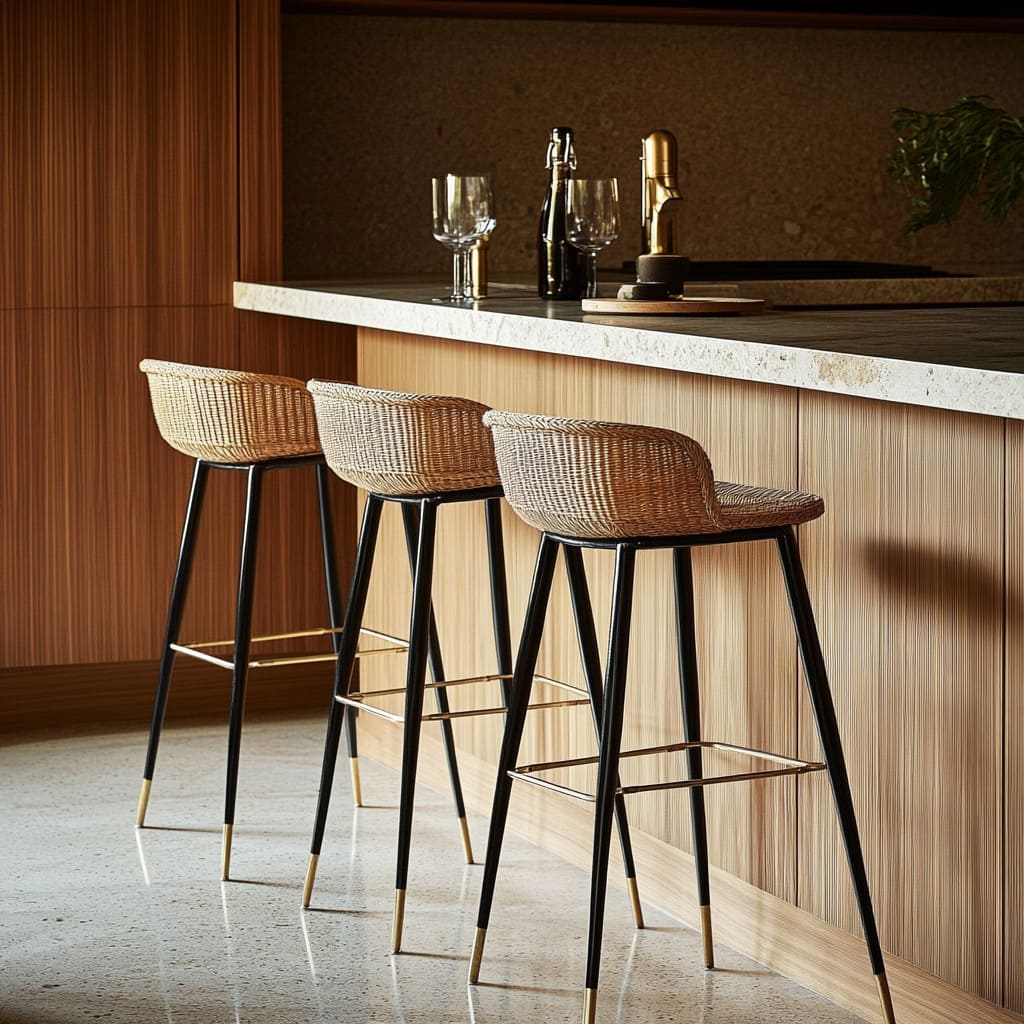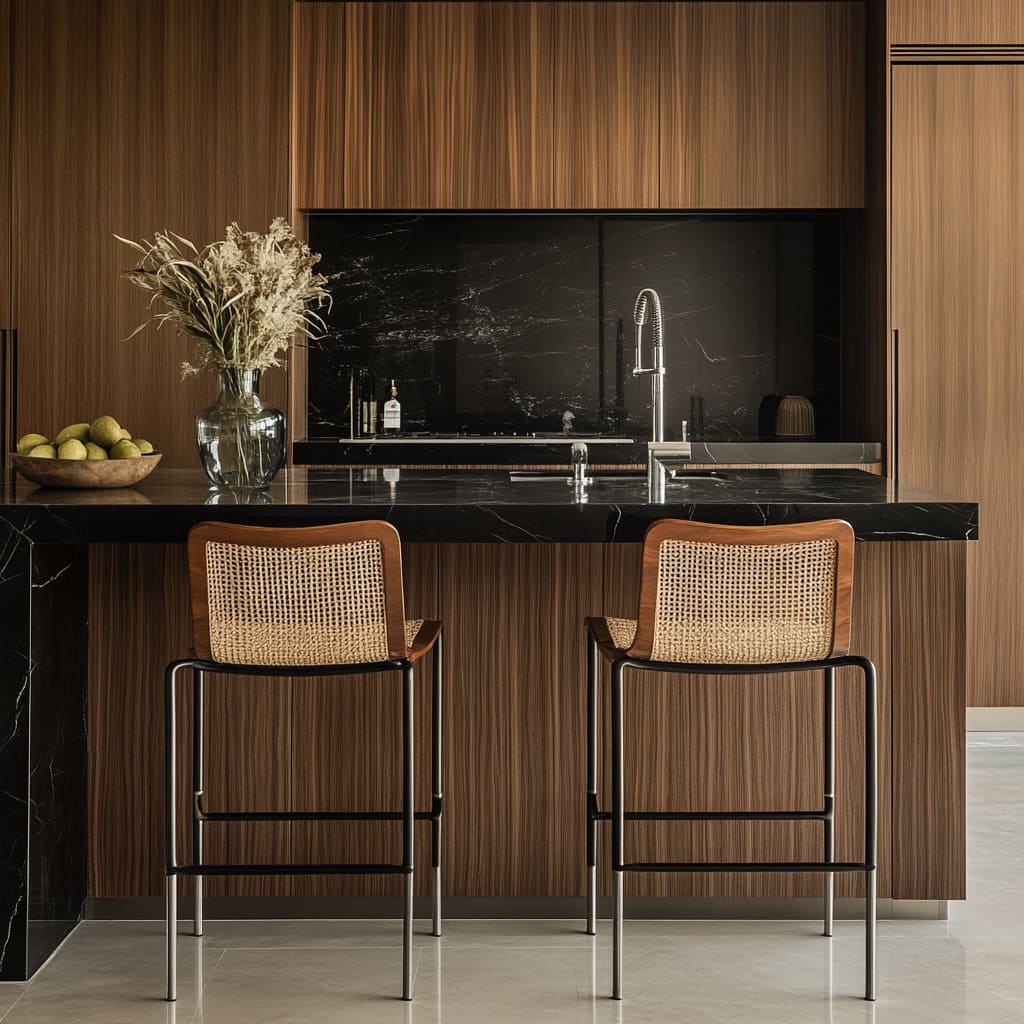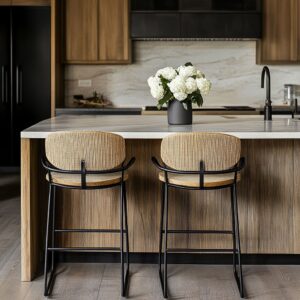Bar stools are no longer simply practical seating options for the kitchen—they’ve become essential design pieces that can shape the character of a space. With an incredible variety of styles, materials, and finishes available, these versatile chairs are now key players in defining a kitchen’s aesthetic and functionality.
Whether your kitchen leans toward sleek modern minimalism, rustic warmth, or a more eclectic mix, the right bar stools can tie everything together while enhancing comfort and usability.
This article dives into the trends, features, and strategies for selecting bar stools that not only match your kitchen’s style but also add to its overall appeal. From woven textures and metal frames to thoughtful contrasts and ergonomic designs, there’s much to consider in creating a space that feels cohesive and inviting.
Let’s explore the many possibilities these design elements offer and how they can transform any kitchen into a beautifully balanced environment.
Key Design Elements: Materials, Colors, and Shapes
Natural Weaves with Light Wood
These stools emphasize the warmth and charm of natural weaves like rattan, cane, or wicker. Paired with lighter wood finishes such as ash or oak, they create a breezy and inviting look.
Many designs incorporate open-back or softly curved forms, balancing comfort with aesthetics. These combinations are ideal for homeowners looking for kitchen island with seating designs that feel fresh yet timeless.
Natural Weaves with Dark or Metal Frames
For a more dramatic touch, stools in this group blend organic woven materials with darker or metallic frames. Black metal or brushed steel is often used to create a striking contrast between the raw, textured surfaces of rattan or cane and the sleek, modern feel of metal.
This pairing gives a sophisticated, industrial edge, especially in modern bar stool chairs that prioritize both style and durability.
Fully or Partially Upholstered Designs
Comfort takes center stage with stools featuring upholstered seats and backrests. Neutral fabrics, white upholstery, and even leather are popular choices, offering a soft and luxurious feel.
Some designs incorporate unique combinations like a leather seat with a woven backrest or ribbed fabrics for added texture. Frame materials vary widely, ranging from natural wood to bold black metal, ensuring a design that can suit both minimal and eclectic kitchens.
Mid-Century or Retro Influences
Rounded edges, angled legs, and bucket-style seats define this cluster. These stools often nod to retro design while maintaining contemporary appeal.
Lighter wicker paired with slim steel frames and traditional cane elements is common, while darker finishes like walnut subtly hint at vintage inspiration. Their clean yet playful lines make them a versatile option for blending mid-century charm with modern interiors.
Across these categories, the interplay of materials like natural weaves, wood, and metal remains a defining feature. This thoughtful combination not only enhances visual appeal but also adds depth to the overall design, making these stools perfect for a variety of kitchen styles.
Connecting Design Choices: Materials, Colors, and Shapes
Material Pairings
Certain materials seem to naturally go together, creating a cohesive and intentional look. Rattan and cane, with their organic textures, are commonly seen paired with either sleek black metal frames for a modern contrast or medium-to-light wood tones to maintain an earthy feel.
On the other hand, leather or fabric upholstery is often found with fully wooden frames, enhancing a warm, classic aesthetic, or with slim metal frames for a more contemporary and streamlined effect. These material combinations are especially popular in contemporary bar stools designed to bridge style and comfort.
Color Relationships
The interaction between cabinetry and stool design often shapes the overall tone of a kitchen. For example, darker cabinetry tends to pair with stools featuring natural textures, such as rattan or neutral fabric seats, creating a pleasant contrast.
Conversely, lighter cabinetry often incorporates stools with black or darker frames, flipping the contrast for a more dramatic effect. These thoughtful contrasts allow for flexibility when brainstorming ideas for kitchen islands with seating that complement a variety of interiors.
Structural and Shape Links
The shape of the stool frequently mirrors the design intent of the space. Curved backrests, often present in mid-century-inspired designs or woven seats, prioritize comfort while adding visual softness to the room.
Meanwhile, slim and angular frames are more prominent in spaces that lean toward a modern-industrial or contemporary aesthetic, emphasizing clean lines and minimalism.
Decorative Ties
Styling elements often echo the materials and colors of the stools themselves. Greenery or dried foliage in vases is a recurring accent, complementing the natural textures of woven stools.
Additionally, metallic accents, such as faucets or cabinet hardware, frequently reflect the finish of the stool legs, tying the space together with subtle harmony. By paying attention to these correlations, homeowners can ensure their stool choices not only complement their kitchens but also create a balanced and visually appealing environment.
The interplay of materials, colors, and shapes is key to designing a cohesive kitchen space.
Trending Styles for Kitchen Bar Stools
When it comes to bar stool trends, styles often reflect a mix of aesthetics and practical needs. Let’s break these down into five distinct categories that are shaping modern kitchens today.
Modern-Industrial
This style leans on clean lines and bold contrasts, often showcasing black metal frames paired with woven rattan or minimal upholstery. The angular structure of these stools complements industrial-themed spaces, where the mix of raw materials and straightforward designs creates a striking yet understated look.
These stools thrive in kitchens aiming for a sleek and functional vibe.
Modern-Rustic
Combining natural and darker tones, this style often features deep wood finishes like walnut alongside rattan or cane detailing. The rustic warmth of the wood contrasts beautifully with the airy texture of the weaving, striking a balance between traditional charm and contemporary aesthetics.
This category works particularly well in kitchens that prioritize coziness without sacrificing modernity.
Scandinavian-Inspired
Known for its minimalist charm, this style champions light woods, such as ash or oak, neutral upholstery, and subtle, streamlined shapes. The overall design ethos of Scandi style bar stools is simplicity and functionality, making them perfect for open, airy kitchens.
These stools often blend into the space without overwhelming it, adding a touch of effortless sophistication.
Mid-Century Appeal
A nod to timeless design, mid-century stools are characterized by rounded frames, bucket-style seats, and occasionally tapered legs. They bring a retro feel to the kitchen while maintaining a polished and modern edge.
These stools are as much about form as they are about comfort, offering a balance that works in both traditional and modern settings.
Retro-Modern Fusion
This category blends nostalgic elements with updated designs. Cane backs paired with warm wood frames are common, often accented by black details for a sharp contrast.
These stools offer versatility, fitting effortlessly into kitchens that mix contemporary and vintage elements. Their understated charm and attention to detail make them a favorite for eclectic spaces.
From the crisp look of contemporary bar stool chairs to the inviting simplicity of Scandinavian designs, these styles reflect the evolving tastes of modern homeowners. By tailoring your stool choice to your kitchen’s broader design, you can create a harmonious, functional, and visually appealing space that suits both style and practicality.
Key Observations in Bar Stool Pairing
The interplay between cabinetry, finishes, and stool styles often determines the overall harmony of kitchen designs. By identifying recurring patterns, we can uncover how bar stool designs contribute to a balanced aesthetic.
For Kitchens with Dark Cabinetry
Dark cabinets often demand a softer touch in stool design to avoid overwhelming the space. Lighter weaves, such as rattan or cane, and neutral-toned upholstery are commonly paired with these kitchens.
This contrast creates a brightening effect, balancing the darker tones with organic, inviting textures. The combination feels cohesive yet ensures that the stools stand out as key design elements.
For Kitchens Featuring Strong Industrial or Metallic Accents
In spaces with industrial inspiration or metallic details, like brushed nickel or stainless steel, stools with black metal or chrome frames are frequently chosen. These materials echo the industrial vibe while tying together the metal finishes of fixtures such as faucets, handles, or even lighting.
The result is a streamlined and unified look where the stools feel intentionally integrated.
For Kitchens Emphasizing Warmth and Comfort
Cozy kitchens often prioritize comfort, which is reflected in the stool choices. Upholstered designs with padded seats, soft fabric covers, or even leather finishes are popular here.
These options not only enhance the visual warmth but also contribute to the inviting nature of the space, making it feel more lived-in and relaxed.
For Highly Minimalist Kitchens
Minimalist interiors follow the principle of simplicity in both form and material. Stools with clean, monochromatic upholstery or subtle weaving complement these kitchens best.
Thin, linear frames and muted tones work to preserve the uncluttered and serene nature of such spaces, emphasizing function without unnecessary detail. These trends show how bar stools can adapt to the stylistic demands of a kitchen while still acting as an essential design piece.
From industrial edges to the soft, inviting appeal of upholstered seats, every choice contributes to an overall aesthetic balance.
The Balance Between Natural Warmth and Contemporary Structure
Modern kitchens often find their aesthetic strength in the seamless blending of organic elements with sleek, industrial finishes. This combination highlights the interplay between timeless textures and contemporary functionality.
Nature-Inspired Details
References to materials like rattan, wicker, cane, and natural wood grains highlight an earthy, grounded theme. These materials evoke a sense of connection to nature, particularly when paired with accents like dried foliage or olive branches, which are often used to reinforce this organic style.
The tactile quality of these natural textures makes them inviting while also ensuring that the stools feel like a centerpiece rather than an afterthought.
Modern and Industrial Accents
On the other hand, black metal, brushed steel, and chrome-finished legs often make an appearance, providing a sleek contrast to the natural materials. Slim, minimalist frames are a recurring theme, subtly supporting the organic warmth without overwhelming it.
These industrial details act as balancing agents, ensuring the design remains modern while grounded in practicality.
Comfort-Driven Design
Ergonomic features such as curved or angled backrests, padded seats, and footrests show that comfort is not sacrificed for style. These thoughtful additions cater to long periods of use, making the stools not only visually appealing but also functional.
The balance between aesthetic elegance and user comfort exemplifies the adaptability of a modern bar stool design to various needs and spaces.
A Popular Fusion
This repeated combination of natural textures and modern structure demonstrates the versatility of these designs. Whether accentuating a minimalist kitchen or softening an industrial one, this style bridges the gap between organic warmth and contemporary refinement, creating a balanced yet dynamic focal point in any home.
Key Design Themes in Bar Stool Selection
The use of materials, finishes, and structural details in kitchen bar stool design reveals thoughtful trends that combine comfort, style, and practicality. This section explores how woven elements, ergonomic details, and finishes play a role in the aesthetics and functionality of modern kitchen stools with backs.
The Prominence of Woven Details
Woven backs and seats are a recurring feature across multiple styles, from modern and industrial to Scandinavian and rustic. These tactile materials, such as cane and rattan, create warmth and texture, counterbalancing the harder surfaces typically found in kitchens, such as stone countertops and metallic appliances.
The soft, earthy quality of woven elements adds depth, making these stools not just functional but visually inviting as well.
Footrest Placement and Structural Ergonomics
The consistent presence of footrests in a forward-facing position highlights a commitment to ergonomics. Many stools also include crossbars near the base, providing additional structural integrity while maintaining comfort.
This attention to footrest height aligns perfectly with standard kitchen island dimensions, ensuring that users can sit comfortably at islands ranging from 36 to 42 inches tall.
Reflective vs. Matte Metal Finishes
An interesting contrast emerges in the use of finishes. Kitchens featuring matte cabinetry and countertops often introduce reflective metals in stool legs, such as polished chrome, to bring a subtle gleam to the space.
Conversely, in kitchens with glossy or polished surfaces, brushed or matte metal finishes are preferred, reducing visual glare and creating a balanced aesthetic.
Balancing Lines and Curves
Where kitchen cabinetry emphasizes straight lines and angular forms, stools with subtle curves, like arched cane backs or gently rounded bucket seats, add visual softness. In contrast, when cabinetry includes paneling or other softer details, stools with angular frames are chosen to provide structure and contrast.
This dynamic interplay ensures the stools contribute to a balanced overall design.
Greenery as a Supporting Element
A recurring decorative theme across designs is the use of natural elements such as dried grasses, olive branches, or foliage arranged in vases. Paired with woven materials in stools, these touches emphasize a calm, organic feel, complementing the trend of blending natural materials with modern lines.
These decor choices anchor the stools within a cohesive kitchen design that feels both warm and contemporary. By incorporating these thoughtful design elements, modern kitchen stools with backs seamlessly bridge style and utility, reinforcing a balance of textures, shapes, and finishes within today’s kitchen spaces.
Practical Tips for Choosing Kitchen Bar Stools
When integrating bar stools into your kitchen design, focusing on proportions, materials, and functionality ensures a seamless blend of style and practicality. Whether you’re selecting stools for everyday meals or a statement addition, these considerations can help guide your choices.
Evaluate Proportions and Comfort
The height of your stools is key to achieving a comfortable seating arrangement, especially for islands with non-standard heights. Kitchens with taller islands may require designer bar stools featuring slightly higher seats, properly positioned footrests, and supportive backrests.
Opting for stools with ergonomic features, such as a slight seat contour or curved back, ensures a comfortable experience for longer use.
Coordinate Materials for Balance
Material choices play a significant role in defining the visual harmony of your kitchen. For darker cabinetry, stools with natural weaving or lighter upholstery can create a striking contrast.
Conversely, lighter cabinetry benefits from stools with darker frames or seat fabrics, adding richness and depth to the overall aesthetic. This thoughtful coordination ensures your kitchen feels cohesive and balanced.
Incorporate Organic Textures
To break up sleek, minimalist kitchen designs, consider bar stools that feature woven or cane details. These elements introduce warmth and texture, softening the overall appearance and creating a more inviting atmosphere.
The tactile quality of these stools prevents a flat or overly streamlined look, making the space feel dynamic and layered.
Match Metal Finishes Thoughtfully
When your kitchen includes prominent metal finishes—such as brushed steel hardware, black faucets, or chrome accents—choosing stools with complementary metal legs or accents helps tie the design together. This consistency ensures that no element feels out of place, giving the kitchen a polished, well-planned feel.
Consider Maintenance Requirements
Practicality matters, especially in busy kitchens. Woven materials like rattan or cane require gentle upkeep to maintain their texture and durability, while fabric-upholstered stools might benefit from stain-resistant treatments.
Balancing these considerations with your style preferences ensures your stools remain both beautiful and functional over time.
Focus on Ergonomics
For extended seating at the kitchen island, look for stools that prioritize comfort. Features such as curved backrests, a stable footrest position, and seats with slight contours offer support and stability.
These considerations not only enhance the usability of the stools but also add to the overall enjoyment of your kitchen space. By thoughtfully aligning materials, proportions, and functional features, you can create a harmonious design that complements your kitchen’s character.
Whether you’re drawn to modern textures or classic finishes, the right stools can elevate both the style and practicality of your space.
Key Takeaways in Kitchen Bar Stool Design
Analyzing the overarching patterns in bar stool design reveals how these versatile pieces contribute both function and style to modern kitchens. Below are some key observations that highlight trends and practical choices.
Woven Materials Lead the Way
A significant number of designs feature woven elements such as rattan, cane, or wicker. These materials not only add a warm, natural texture but also help soften the visual weight of harder surfaces like stone countertops and metal fixtures.
Their versatility allows them to pair effortlessly with various styles, from rustic to contemporary.
Contrast as a Core Element
Contrast emerges as a common strategy in pairing stools with kitchen features. Dark cabinetry and countertops often feature stools with lighter weaves or natural-toned fabrics, creating a visual balance.
Similarly, kitchens with lighter cabinetry benefit from stools with black or dark metal frames, which add depth and definition to the design.
Metal Frames for Structure and Style
Black metal and chrome frames dominate many modern designs, offering both structural integrity and a sleek aesthetic. These materials complement industrial, minimalist, and contemporary kitchen styles, making them a popular choice for homeowners seeking clean lines and durable functionality.
Comfort through Upholstery
In kitchens where comfort is a priority, upholstered stools take center stage. Materials like leather and neutral-toned fabrics not only enhance the seating experience but also add a layer of sophistication.
These stools often appear in spaces designed for extended gatherings, combining style with usability.
Organic Accents Tie It All Together
Decorative foliage, vases, and other natural elements consistently appear in these designs, mirroring the warm textures of woven stools. These accents provide an organic, cohesive feel that complements the broader design narrative.
The use of earthy elements reinforces the welcoming ambiance that modern kitchens aim to create.
Balancing Heaviness with Lightness
Bar stools often act as a design counterbalance in kitchens with dominant stone or dark wood elements. Their softer textures and lighter materials bring a sense of equilibrium, ensuring the overall space feels approachable and harmonious.
These patterns underscore the thoughtful balance between materials, textures, and functionality in stool designs. Whether you’re exploring kitchen island chair ideas or considering how to integrate complementary accents, these insights can help you curate a cohesive and inviting kitchen environment.
Final Reflections on Bar Stool Design Choices
Bar stools play a pivotal role in tying together both the style and functionality of a kitchen. They are far from being an afterthought; instead, they represent a key element that bridges cabinetry, countertops, and overall design themes.
As seen throughout the analysis, every design choice—whether involving weaving techniques, material pairings, or color contrasts—is deliberate and impactful.
Balancing Comfort and Aesthetic
The wide variety of styles, from woven natural textures to sleek metal or upholstered designs, reflects a dual focus on practicality and beauty. For kitchens that prioritize gathering and socializing, stools with ergonomic backrests or plush seating offer the necessary comfort.
Meanwhile, minimalist kitchens benefit from lightweight, angular frames that maintain visual simplicity.
Creating Cohesion Through Materials
One of the most noticeable patterns is how bar stools echo or contrast with existing kitchen materials. Organic elements such as cane, wicker, and rattan provide warmth to kitchens dominated by stone or metal finishes.
Conversely, metallic stools or darker frames can introduce structure and contrast to lighter, wood-forward spaces.
The Subtle Art of Contrast
Contrast remains a key strategy in elevating the stool’s role within kitchen design. Whether it’s a light, woven seat paired with dark cabinetry or chrome frames against muted countertops, these elements ensure visual interest while enhancing the room’s overall composition.
Considering Practicality for Daily Use
Practicality is another significant factor in choosing bar stools. From ensuring footrests are at comfortable heights to selecting materials that require minimal maintenance, these functional details shouldn’t be overlooked.
Stools with woven elements may require occasional care to maintain their texture, while fabric seats may benefit from protective treatments in high-use areas.
Enhancing the Design Narrative
Bar stools also provide an opportunity to add layers to a kitchen’s story. For those exploring kitchen counter stool ideas, the inclusion of greenery or earthy decor alongside stools with natural textures creates a grounded and inviting atmosphere.
On the other hand, incorporating sleek, industrial designs can lend a more contemporary edge. Ultimately, bar stools are more than just seating—they are design elements that can subtly or dramatically influence the atmosphere of a kitchen.
By carefully considering their materials, colors, and shapes, homeowners can create a cohesive and functional space that aligns with their vision.
